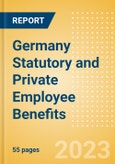The report provides in-depth industry analysis, information, and insights of employee benefits in Germany, including an overview of the state and compulsory benefits in Germany, detailed information about the private benefits in Germany, insights on various central institutions responsible for the administration of the different branches of social security and the regulatory framework of the employee benefits in Germany.
Germany has a well-developed social security system. Both companies and employees equally contribute to social security schemes. Employees must primarily contribute to nine statutory social security organizations: the statutory health insurance fund, the statutory long-term care insurance fund, the statutory short-term sickness fund, the statutory long-term disability fund, the statutory pension insurance fund, statutory accident insurance, statutory maternity, and paternity fund, statutory family benefits, and the statutory unemployment insurance fund. Employers deduct tax and social security contributions from the gross wages of employees and directly transfer them to the tax office. For all the components of social security, there is a common fund. However, employees have the option to individually choose a health insurance provider. The increasing share of elderly people in the population, coupled with a relatively low birth rate, has forced the government to adopt several reforms to ensure a better social welfare system for future generations.
Germany has a well-developed social security system. Both companies and employees equally contribute to social security schemes. Employees must primarily contribute to nine statutory social security organizations: the statutory health insurance fund, the statutory long-term care insurance fund, the statutory short-term sickness fund, the statutory long-term disability fund, the statutory pension insurance fund, statutory accident insurance, statutory maternity, and paternity fund, statutory family benefits, and the statutory unemployment insurance fund. Employers deduct tax and social security contributions from the gross wages of employees and directly transfer them to the tax office. For all the components of social security, there is a common fund. However, employees have the option to individually choose a health insurance provider. The increasing share of elderly people in the population, coupled with a relatively low birth rate, has forced the government to adopt several reforms to ensure a better social welfare system for future generations.
Key Highlights
- German Labor Laws are responsible for the functioning of the overall social security system
- A person’s national insurance contribution is determined based on their income
- An insured person who is unemployed or unable to work and whose benefits have been exhausted is entitled to a credited contribution
- In Germany, employers provide voluntary retirement benefits to their employees through Direct pension commitment, Direct insurance, Pensionskasse, and provident funds
Scope
This report provides a detailed analysis of employee benefits in Germany:
- It offers a detailed analysis of the key government-sponsored employee benefits, along with private benefits
- It covers an exhaustive list of employee benefits, including retirement benefits, death in service, long-term disability benefits, medical benefits, workmen's compensation insurance, maternity and paternity benefits, family benefits, unemployment, long-term care benefits, minimum resources, leaves and holidays, and private benefits
- It highlights the economic and regulatory situations relating to employee benefits in Germany
Reasons to Buy
- Make strategic decisions using in-depth information related to employee benefits in the country
- Assess employee benefits of the market, including state and compulsory benefits and private benefits
- Gain insights into the key employee benefit schemes offered by private employers in the country
- Gain insights into key organizations governing employee benefits market, and their impact on companies
Table of Contents
1. Executive Summary3. Country Statistics4. Overview of Employee Benefits in Germany5. Regulations
2. Introduction
6. State and Compulsory Benefits
7. Private Benefits
List of Tables








